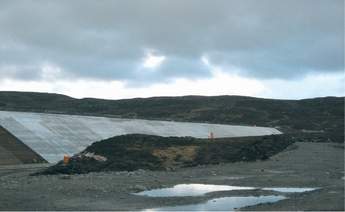As construction nears completion on the 100MW Glendoe project in the Scottish Highlands, IWP&DC spoke to Hochtief, the project’s main contractor, to discover more about the network of tunnels that form an integral part of this scheme

The construction of Glendoe hydro scheme, near Loch Ness, is the largest civil engineering project currently underway in Scotland. Plans for the 100MW project – owned by Scottish & Southern Energy – began as far back as October 2001, but the first formal construction work at the site began in January 2006. Construction is expected to be complete at the end of this year, with first power to be generated in March 2009.
Like most projects of this nature and scale, it is utilising an experienced international team, with expertise from four continents involved. Main contractor for the scheme is Hochtief UK, with Poyry Energy as the project designer and andritz va-tech Hydro as the generation plant subcontractors.
Project details
Glendoe’s network of tunnels is extensive – the system will be served by over 16km of these passageways. An 8.6km tunnel, 4m in diameter, will collect water and bring it into the reservoir while 8km of tunnels, 5km in diameter, will channel water from the reservoir to an underground power station and out into Loch Ness. In addition, a 1250m long access tunnel, 7m in diameter, will lead to the power station cavern. One of the most impressive pieces of machinery used during construction is ‘Eliza Jane’ – the 200m long, 600 tonne TBM manufactured by Herrenknecht, which broke through the Monadhliath Mountain Range in Glendoe to form the headrace tunnel in February this year.
Glendoe’s reservoir will be formed by a 905m-long concrete faced rockfill dam (CFRD) on the River Tarff. The dam is long and low, with a maximum height of 35m for a short stretch in the river valley. It is being constructed from a combination of rock produced by the construction of the Aqueduct Tunnel, and from a quarry opened up adjacent to the dam, which will be flooded by the eventual impoundment of the reservoir. As a sign of the project’s environmental sensitivity, the reservoir and dam will not be visible from any home or public road.
The project’s powerhouse is housed in an underground cavern 250m below ground level, and located roughly 2km from the banks of Loch Ness. The site of the powerhouse initially raised concerns with residents in the nearby village of Fort Augustus. However, once the roads, camp and office areas were established these fears were allayed as Hochtief site management and Health and Safety teams had ensured sufficient plans were positively implemented in the preliminary stages of work, thus reducing negative impacts on the local and wider environment.
The powerhouse cavern is 38m long, 18m wide and 32m high, and will house the turbine and generator. A separate, smaller cavern is also located adjacent to the power station cavern to house the main station transformer. Operation of the powerhouse will be fully automated from SSE’s control room in Perth some 113km away to the south east.
A tailrace tunnel leads from the bottom of the powerhouse to the outfall which is located directly on the banks of Loch Ness itself. In operation, the water will travel the 7.2km from the dam through the headrace tunnel, into the powerhouse, operate the turbine, then drop to the sump for the short 1.1km through the tailrace tunnel into the outfall and Loch Ness.
The chosen sub-contractor for the fit-out in the powerhouse was Andritz va-tech-hydro, who employed a series of contractors to ensure the large scale mechanical and electrical works progressed in a timely and efficient manner. Hochtief also supplied a pro-active management structure to oversee the works and ensure compliance with the renowned UK Health, Safety & Environmental Law.
‘Health & Safety training has played a major part in ensuring the AIR/AFR is maintained at a low as level as possible. It has been both an education and an enlightening challenge to help generate an awareness of health and safety,’ says David Hutchinson – Deputy Project Director. ‘In the multi-national workforce the technical challenges faced were immense. Successful completion of the project depends heavily on the skill and energy on site.’
Jeff Terry, Head of Project Health & Safety, added: ‘The sheer scale and size of the project dictates that positive health and safety principles and techniques are employed for all work areas.’
The Glendoe scheme should be largely complete by Winter 2008, with the project representing a grand continuation of SSE’s hydro heritage, which began with the construction of stations in Northern Scotland in the 1930s. As the architects of the majority of the UK’s renewable energy projects, SSE regard this flagship project as borh embodying an acknowledgement of the past, while symbolizing a sustainable future for energy production.
www.hochtief.co.uk
